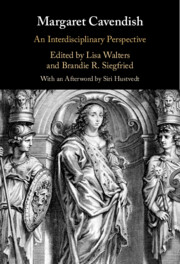Book contents
- Margaret Cavendish
- Margaret Cavendish
- Copyright page
- Contents
- Illustrations
- Notes on Contributors
- In Memoriam
- Acknowledgments
- Introduction
- Part I History of Science
- Chapter One Margaret Cavendish
- Chapter Two Margaret Cavendish Thinks about Sex
- Chapter Three Margaret Cavendish and the Rhetoric and Aesthetics of the Microscopic Image in Seventeenth-Century England
- Chapter Four Margaret Cavendish and the Nature of Infinity
- Part II Philosophy
- Part III Literature
- Part IV Politics
- Part V New Directions
- Afterword
- Chronology of Works by Margaret Cavendish
- Select Bibliography
- Index
Chapter Two - Margaret Cavendish Thinks about Sex
from Part I - History of Science
Published online by Cambridge University Press: 28 April 2022
- Margaret Cavendish
- Margaret Cavendish
- Copyright page
- Contents
- Illustrations
- Notes on Contributors
- In Memoriam
- Acknowledgments
- Introduction
- Part I History of Science
- Chapter One Margaret Cavendish
- Chapter Two Margaret Cavendish Thinks about Sex
- Chapter Three Margaret Cavendish and the Rhetoric and Aesthetics of the Microscopic Image in Seventeenth-Century England
- Chapter Four Margaret Cavendish and the Nature of Infinity
- Part II Philosophy
- Part III Literature
- Part IV Politics
- Part V New Directions
- Afterword
- Chronology of Works by Margaret Cavendish
- Select Bibliography
- Index
Summary
Margaret Cavendish thought of her work as her “childe,” perhaps compensating for her own lack of biological children with her conceptions of nature. In her early works, she claimed that she was too modest to examine the nature of procreation, but later investigates the ideas of both ancients and moderns about the physical and metaphysical aspects of generation. She criticized William Harvey’s biology and understood the possible sexual implications of Robert Boyle’s experimentation with the air-pump. Her developed natural philosophy, that everything was composed of matter in motion, allowed her to advance a non-sexed and non-gendered account of generation. The unitary asexual substratum of matter could allow a man to become a woman, or a woman a man; such gender fluidity was possible because of the diversity of matter and its capacity to change due to particular circumstances. Consequently, Cavendish could be both sexes and none, constructing natural philosophy and generating imaginary worlds. We are left with the question of whether Cavendish thought that gender and even sex are social and cultural constructs, thus anticipating the modern examination of these categories.
Keywords
- Type
- Chapter
- Information
- Margaret CavendishAn Interdisciplinary Perspective, pp. 33 - 50Publisher: Cambridge University PressPrint publication year: 2022

